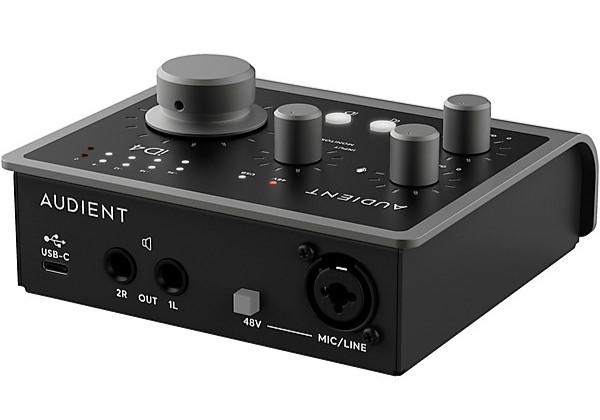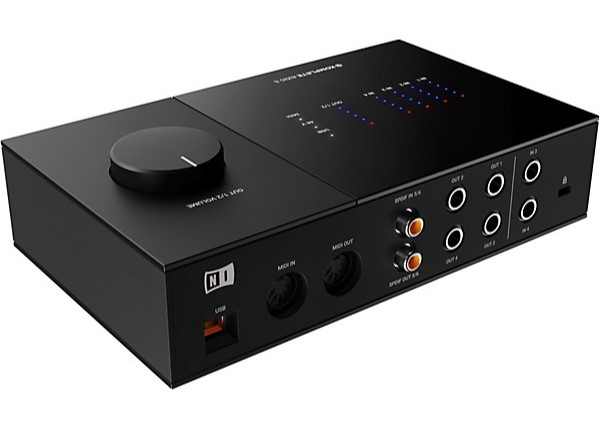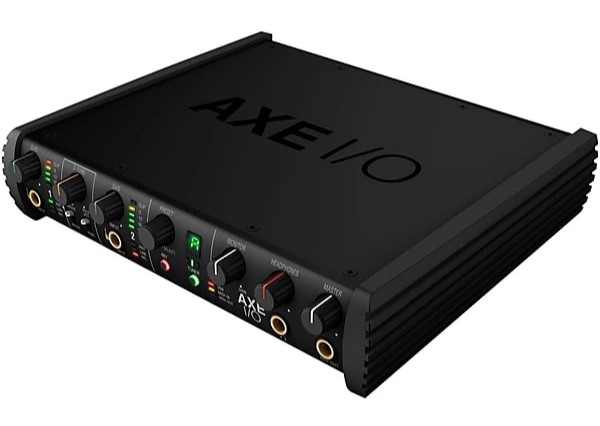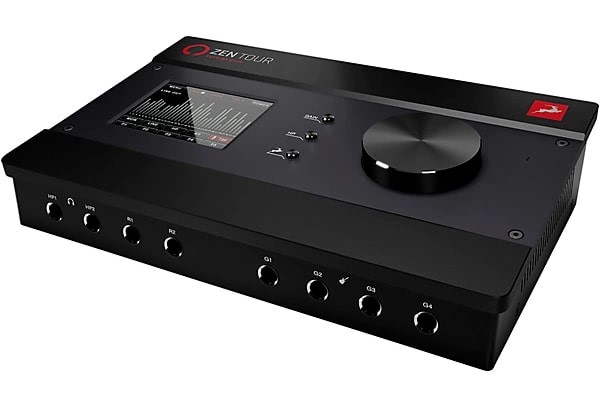When you buy through our links, we may earn an affiliate commission.
If you're a musician recording music at home or on the move, you need a USB audio interface. But you shouldn't go out and buy the first one you find.
The interface is responsible for amplifying the sound, converting the audio from analog to digital, and cutting additional noise.
To make quality recordings, you need a quality interface. But with so many on the market, where do you begin?
Here are the best audio interfaces currently available, from our number 1 pick, the Focusrite Clarette+ 8Pre, to our budget pick, the Audient iD4 MkII.
Quick Summary of the Best USB Audio Interfaces
- Focusrite Clarette+ 8Pre (Best USB Audio Interface Overall)
- Audient iD4 MKII (Best USB Interface for Those on a Budget)
- Native Instruments Komplete Audio 6 (Best Compact Interface)
- IK Multimedia AXE I/O USB Guitar Audio Interface (Best Interface for Guitarists)
- Behringer U-Phoria UMC1820 (Best for Multiple Inputs and Outputs)
- The Universal Audio Volt 276 (Best for Ease of Use)
- Antelope Audio Zen Tour Synergy Core (Best for Onboard Effects)
Best USB Audio Interfaces
There are many audio interfaces to consider, each with its unique audio resolution and input and output options. Some of the best USB audio interfaces available now include:
1. Best USB Audio Interface Overall – Focusrite Clarette+ 8Pre

SPECS
- Connectivity: USB 2.0
- Audio Resolution: 24-bit/192kHz
- Inputs: 8 x XLR-1/4" combo (mic/line), 1 x Coax (S/PDIF), 1 x Optical (ADAT)
- Outputs: 10 x 1/4" (line), 1 x Coax (S/PDIF), 1 x Optical (ADAT), 2 x headphone jack
The high price you pay for the Focusrite Clarette+ 8Pre is made worthwhile when you hear the crystal-clear audio that the interface picks up and digitizes. No outside noise interferes with this Focusrite model.
We've made this our overall best interface choice for the high-grade sound recordings it helps produce.
The Focusrite Clarette+ boasts 8 high-headroom preamps with low noise and distortion. These, alongside the dim, mute, and monitor control buttons, pick up the sound of the instruments in their most natural form.
When playing back you're recording, it will sound live. Plus, with 8 inputs, you can record a whole band simultaneously.
The Focusrite iOS Control App makes it easy for you to control your recording session from the comfort of your phone. On this, you can configure input routing and output monitoring.
Focusrite was founded by Rupert Neve to make mic preamps for Beatles producer George Martin. Neve's legacy is well maintained with the high-quality and crystal clear Focusrite Clarette+ 8Pre.
2. Best USB Interface for Those on a Budget – Audient iD4 MKII

SPECS
- Connectivity: USB 3.0
- Audio Resolution: 24-bit/96kHz
- Inputs: 1x 1/4" instrument, 1 x XLR-1/4" mic/line combo
- Outputs: 2 x 1/4", 2 x headphone jack
If the Focusrite Clarette+ 8Pre is outside your budget, the Audient iD4 MKII allows you to digitize your analog inputs for a fraction of the price. For $199, you can record and convert your music using the Audient iD4 MKII.
Despite its low price, this interface produces recordings that sound crystal clear. With a reasonable audio resolution of 24-bit/96kHz, audio captured using this device sounds natural, with nuances well maintained.
Plenty of useful functions are also built-in, such as a loopback feature and the scroll wheel. The latter allows you to control the parameters of your audio workstation easily.
Of course, a smaller price means more limited features. Its 2 input options are limited compared to Focusrite Clarette+'s 8 analog input options.
However, the Audient iD4 MKII is still a great option for solo recording. It's also ideal if you don't mind recording instruments and vocals individually.
On the other hand, some degree of collaboration is attainable using this audio interface. With dual headphone outputs, you and your musical partner can simultaneously listen in on the recording process.
3. Best Compact Interface – Native Instruments Komplete Audio 6

SPECS
- Connectivity: USB 2.0
- Audio Resolution: 24-bit/192kHz
- Inputs: 2 x XLR-1/4" combo (mic/line), 2 x 1/4" TRS (line), 1 x Coax (S/PDIF)
- Outputs: 4 x 1/4" TRS (DC coupled), 1 x Coax (S/PDIF); 2 x headphone jacks
The Native Instruments Komplete Audio 6 is priced slightly above the Audient iD4 MKII, but it's worth paying more for its slick design and higher input/output compatibility.
This edition maintains the sleekness and compactness of the models that came before it, only with more advanced features and uses.
The 24-bit/192kHz audio resolution creates a warm tone, particularly when you hook up mono instruments to this interface (being suitable for both stereo and mono recordings). You can switch between mono and stereo with a simple push of a button.
We've chosen this model as our favorite compact interface because, despite all its features, it takes up relatively little space. Its sleek design also makes it one of the most impressive audio interfaces on this list in terms of appearance.
This audio interface makes it easy to record two instruments simultaneously and have two people listening at once. The listening experience is made better through the individual adjustable volume feature on the headphone outputs.
4. Best Interface for Guitarists – IK Multimedia AXE I/O USB Guitar Audio Interface

SPECS
- Connectivity: USB 2.0
- Audio Resolution: 24-bit/192kHz
- Inputs: 2 x 1/4" (Hi-Z), 2 x XLR-1/4" combo (mic/line)
- Outputs: 4 x 1/4" (line out), 1 x 1/4" (amp/re-amp out)
Designed with two Hi-Z inputs, this interface can precisely capture audio from both passive and active pickups. These inputs also come with a Z-Tone dial. This allows you to shape the tone of your guitar playing in whichever way you want before recording.
To further improve your guitar tone, you can hook up single/double footswitches or an expression pedal via the controller inputs.
Unlike the Native Instruments Komplete Audio 6 and the Audient iD4 MKII, the IK Multimedia AXE I/O is not designed for collaboration. There's only one headphone output, and its features are designed exclusively for guitar playing.
So, if you want to record guitar and drums simultaneously, you'd probably be better off with another USB audio interface.
Still, there are two inputs on the front of the device for you to plug in two separate guitars. Round the back, you'll find two combo inputs that can be used for both mics and line instruments.
To learn more about guitar audio interfaces, check out our recommended list of the 7 Best Guitar Audio Interfaces.
5. Best for Multiple Inputs and Outputs – Behringer U-Phoria UMC1820

SPECS
- Connectivity: USB 2.0
- Audio Resolution: 24-bit/96kHz
- Inputs: 8 x XLR-1/4" combo, 1 x Coax (S/PDIF), 1 x Toslink (ADAT)
- Outputs: 2 x 1/4" (main out), 8 x 1/4" (line out), 1 x Coax (S/PDIF), 1 x Toslink (ADAT), 2 x headphones
The Behringer U-Phoria UMC brings your home recording studio as close to the real thing as possible, with an impressive 18-input and 20-output compatibility.
Despite its scale, this audio interface is good for both beginner home recorders and experts. With individual knobs for each output and input, it's incredibly easy to control this Behringer model.
Plus, for its current low price of $299, you'll unlikely find a USB audio interface of this scale for close to this price.
Whether you want to record solo or record the simultaneous noise of a 10-person band, the Behringer can pick up as much or as little as you need. You can connect a whole range of digital and analog devices, with plenty of digital ports and MIDI connectivity available.
The cons of this product include the relatively low 96kHz sampling rate (which is the same as the Audient iD4 MKII) and, obviously, the bulky size of the device.
6. Best for Ease of Use – The Universal Audio Volt 276

SPECS
- Connectivity: USB 2.0
- Audio Resolution: 24-bit/192kHz
- Inputs: 2 x XLR/1/4" combo (mic/instrument), 2 x 1/4" line
- Outputs: 2 x 1/4" L/R, 4 x 1/4" line; 1 x headphones
This Universal Audio interface allows you to compress your music with ease. Although achieving the classic analog recording sound is normally difficult for rookies, this Universal Audio product makes it easy.
With 3 compressor presets available, smoothing out your audio is a straightforward task - which is why we've picked this as the best interface for ease of use.
The compressor has three buttons - guitar, vocals, and drums. This makes switching between audio types as simple as pushing a button.
The Universal Audio Volt 276 is also affordable, portable, and has minimal latency.
Although the audio resolution of 24-bit/192kHz isn't unique compared to other interfaces on this list, the sound produced is warm and clear.
If you want to capture the atmosphere of 60s recordings in a digital format, the Universal Audio Volt 276 can help you do it.
7. Best for Onboard Effects – Antelope Audio Zen Tour Synergy Core

SPECS
- Connectivity: USB 2.0
- Audio Resolution: 24-bit/192kHz
- Inputs: 4 x Hi-Z/Line Inputs, 4 x Mic/Line Inputs on Combo XLR jacks
- Outputs: 1 x Monitor Out Pair on TRS 1/4 Jacks, +20 dBu max, 8 x Line Outs on TRS, +20 dBu max (DC-Coupled), 2 x Stereo Headphone Outputs, 2 x Re-amp Outputs
The Antelope Audio Zen Tour Synergy Core may be small, but it outperforms most audio interfaces in terms of picking up an audio signal and onboard effects.
It has an audio resolution of 24-bit/192kHz, which beats other compact options such as the Audient iD4 MKII.
So, you can use this Antelope model to pick up all musical nuances and then subject these nuances to onboard effects.
The Antelope Audio Zen comes with 36 effects as standard. This includes compressors (which are just as good as the Universal Audio model), EQs, and guitar amps.
In terms of actual sound quality, the AD/DA converters provide excellent separation and width, and the preamps pick up and produce a clean recording.
If you like the Universal Audio Volt 276 but want better sound quality, this interface can deliver what you need.
Best USB Audio Interfaces Buyer's Guide
Besides price, there are several factors that a buyer should consider before purchasing a USB audio interface. Specifically, sound quality, resolution, and input and output count need to be considered.
You should also think about how many features you're getting for the price and how compatible the device is.
To help you out, here's how to judge whether the interface is right for you:
Audio Quality and Resolution
Audio and resolution must be high quality to digitize your analog inputs authentically. Otherwise, the digital version of your music will sound completely different from how you played it. Subtle nuances in your sound will be lost, resulting in a low-quality listening experience.
An interface with good-quality audio and resolution will be able to isolate your music better. There will be less distortion and background noise, which makes your music crisper. A wider dynamic range is also created, allowing you to capture both loud and soft sounds.
You can judge the audio and resolution of a product by looking at its specs. High sample rates and bit depths are indicative of high audio quality. The bit depth should support 24-bit conversion at a sample rate of at least 44.1 kHz or higher. This will ensure your analog recordings are accurately digitized.
You should also check to see if the interface manufacturer provides any audio samples of audio recorded using the product. Samples can be a good indicator of how well the audio interface can pick up and reproduce sound.
Inputs and Outputs
The number of inputs and outputs you require depends entirely on the type of music you record and how many instruments you use.
If you record one instrument at a time, you'll only need one or two inputs maximum. This way, you have to switch input devices between recordings, which you can mix on your audio workstation.
However, you'll need far more input ports to record a full band simultaneously. Similarly, the number of output ports you need depends on your setup. If you work on your own, one or two outputs will suffice. However, you'll need more than two headphone outputs if multiple people need to listen.
You also need to look at the type of inputs and outputs that are provided with the interface. XLR inputs are most commonly used for microphones, while TRS inputs are used for guitar, drums, and other instrumental inputs.
You can also get MIDI inputs, which connect drum machines, keyboards, and controllers.
There are also different outputs you need to consider. For example, line outputs are used for powered speakers and studio monitors. Headphone outputs are obviously only for headphones, while digital outputs are used to connect external hardware such as mixers.
Budget and Features
As proven in this article, the higher the price, the more additional features an audio interface has. So, you need to define what features you need and the budget you have for an audio interface.
Although it can be difficult to guess what specific features you'll require in the long run, think about the types of recording sessions you currently take part in. What instruments and output devices do you require every single time?
Do you need MIDI connectivity, multiple headphone output points, or phantom power for condenser mics? These are all consideration points that will impact the price of your interface. So, only invest in what you immediately need.
Looking at the compatibility features and expansion possibilities of a USB interface can also help you make a buying decision. It may be worth buying an audio interface with additional inputs and outputs, should you need them.
ADAT and S/PDIF connections would mean you could expand your audio interface set-up in the future.
Some USB audio interface models can be daisy-chained to other models. For example, the Steinberg AXR4 features two Thunderbolt 2 ports, which allows you to connect with three other interfaces.
Should you need more features, you could invest in another audio interface that features what you need.
Preamps and Gain
Quality preamps are required to pick up and support the otherwise weak audio signals given off by microphones. Without them, the sound quality of your recording is significantly lowered and likely plagued by distortion and exterior noise.
The quality of a preamp can be judged by examining product specs. For example, a high signal-to-noise ratio (SNR) would suggest the product produces a cleaner, less distorted sound than a product with a low SNR rating.
Similarly, a low total harmonic distortion (THD) rating reflects good sound quality. Premium interfaces should also feature wide frequency response.
An audio interface can further be judged by the range of gain offered. A good gain range would be somewhere between 50 dB to 60 dB. However, it depends on what you plan on recording.
Low audio interfaces with a gain range of 20 to 40 dB are good at picking up sensitive microphones or line-level signals. If you're recording with ribbon microphones, a low gain range would be preferred.
On the other hand, if you're working with a low-output microphone, you definitely need over 70 dB worth of gain to pick up the sound.
Frequently Asked Questions (FAQs)
What are the differences between USB 2.0 and USB 3.0 audio interfaces?
The main differences between USB 2.0 and USB 3.0 audio interfaces are the data transfer speed, power delivery, cable design, compatibility, and bandwidth allocation.
A USB 3.0 can transfer at a rate of 5 Gbps (gigabits per second). A USB 2.0, on the other hand, can only transfer at a rate of 480 Mbps (megabits per second).
In terms of power, a USB 3.0 audio interface can deliver 900 mA worth of power. A USB 2.0 can only deliver 500 mA worth of power.
Are USB audio interfaces compatible with both Windows and macOS?
Most contemporary interfaces are designed to be compatible with both Windows and macOS. Interface manufacturers tend to offer users two separate software options - one for Windows and one for macOS.
Before buying a USB audio interface, it would be worthwhile to check that it's compatible with your computer first.
What is latency, and how does it affect USB audio interfaces?
"Latency" refers to the brief period between making and hearing a sound. In terms of USB audio interfaces, latency is the time it takes for the audio to travel through the interface, get processed by the computer, and return as output.
High latency could be an issue for recording, as it means you can't monitor your recording in real time.
High latency makes it difficult to record and mix, as the output is essentially out of sync from your playing. Ideally, you need a USB audio interface with minimal latency.
Can I use multiple USB audio interfaces simultaneously?
It is possible to use multiple interfaces at the same time and have them each recognized by your digital audio workstation. Before doing this, you'll likely have to configure your audio interface software.
This normally involves selecting multiple additional USB audio interfaces as input and output channels.
The sample rate and clock settings on your software will also have to be edited so that each USB audio interface is in sync with the others.
Conclusion
If you want to produce quality recordings from home, you need to add an interface to your audio equipment. Without it, you won't be able to capture the nuances, warmth, and general sound quality of live music.
When buying an interface, make sure it offers an audio resolution of at least 24-bit/44.1 kHz. Additionally, ensure that it has the right level of input/output options for your recording needs.
Our top audio interface choice is the Focusrite Clarette+ 8Pre due to its 8 high-headroom preamps, usability, and premium audio capturing.
We'd also recommend the Audient iD4 MKII, and the Native Instruments Komplete Audio 6, as being amongst the other best audio interfaces mentioned in this article.
